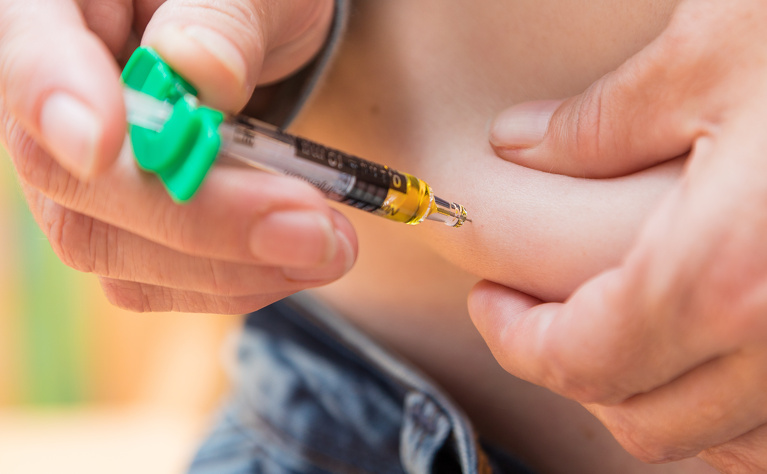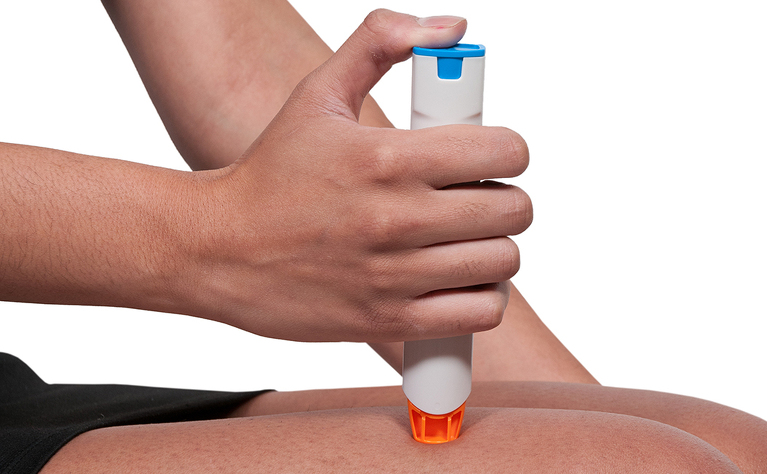Some types of biologic medications used to treat Crohn's disease and ulcerative colitis need to be injected. Find out more about doing your own injections at home.

The thought of learning to inject yourself can be pretty daunting, especially if you’ve never done it before.
This article will look more closely at what to expect when injecting biologics, suggesting tips to help make it a little easier for you.
Biologics are medicines genetically engineered from living cells, that target certain proteins and enzymes in your body involved in causing inflammation. They are commonly used to treat and maintain remission in Crohn’s disease or ulcerative colitis.
Biologic medicines can be given by subcutaneous injection, intravenous (IV) infusion, or orally as tablets.
Biologic medicines given by subcutaneous injection include:
A subcutaneous injection uses a short needle to inject medicine into the tissue layer between your skin and muscle. Medicine given in this way is usually absorbed more slowly than medicine given directly into your vein. This type of injection is often used to deliver a medicine that can't be given by mouth, because it will be destroyed by the acid and enzymes in your stomach.
At first, a doctor or nurse will give you your biologic injections, however once you are used to having your medicine this way, they will teach you how to inject yourself.
This is a difficult question to answer. Everyone experiences pain and having injections differently. Some people report varying levels of pain and stinging sensations, and some report no pain at all. In general people find any discomfort tolerable enough to continue doing injections.
Quite often the build up to and worry about the injection is worse than the actual injection itself, which is over very quickly. Many people find it becomes easier after they’ve had a few injections, and know what to expect.
Some biologic medicines come in prefilled syringes. These are single dose, single use syringes with a needle attached. The person who is giving the injection inserts the needle and presses the syringe plunger themselves, controlling the speed of delivery of the medicine.
Some biologic medicines come in prefilled injection pens. They are single use devices that contain one dose of your medicine. They are very simple to use and patient friendly, automatically inserting a needle (which is hidden inside the pen) and delivering the medicine with one click.

How often you have your biologic injection, and the dose you have, will depend on the type of biologic you have been prescribed, your condition and disease activity. You will usually start with a ‘loading dose’ of your biologic. This is usually a higher dose, sometimes given more frequently in order to encourage a rapid response to the biologic medicine. If you have been prescribed ustekinumab, your loading dose will be delivered by an infusion in hospital.
To begin with you will be given your injections in hospital by your doctor or nurse. Once you are used to having your biologic medicine this way, you will be taught how to inject yourself, so you can do it at home. Some people aren’t keen on the idea of self injecting, and it may be possible for a family member or friend to be trained to give you your injections.
When you are ready to have your injections at home it can be arranged for a delivery company to bring them to you. They will also bring you a sharps container to safely dispose of used items. You can usually arrange delivery dates and request more supplies with the company directly, either by telephone or online.
Keep an eye on your supply of syringes or injection pens. Make sure you request your next delivery in plenty of time so you don’t miss a dose. Some delivery companies will contact you to arrange delivery before you run out, but you shouldn’t rely on this.
Biologic medicines must be stored in the fridge, between two and eight degrees centigrade. They should be kept in their original packaging to protect them from light.
Some biologic medicines can be stored at temperatures of up to 25 degrees centigrade for between 14 and 30 days, as long as they are protected from light. This is useful if you are going to be travelling or away from home when your injection is due. Check specific guidelines for storage of your biologic medicine with your IBD team. You should not refrigerate biologic medicines again once they have been kept out of the fridge.
Make sure you put newer deliveries of your medicine to the back, using older medicines first. This way none should pass their expiry date and become unusable.
It is totally normal to be worried or nervous about self injecting, especially at first. Pick a time where you can be as relaxed as possible, and won’t feel rushed. It might also help to have someone you trust with you.
Please note, the following instructions are a general guide. Always follow specific instructions given to you when you were trained to self inject, and patient information leaflets that accompany your medicines.
Syringe
Injection pen
That’s it, you’re done! You may find you experience a little redness, swelling, discomfort, warmth or itching at the site of the injection. This is normal and nothing to worry about. Some people find this can be soothed by applying an ice pack or cold compress to the area.
However if you start to feel unwell, or are worried you may not have successfully delivered your biologic medicine, contact your IBD team immediately - they will advise what to do next.